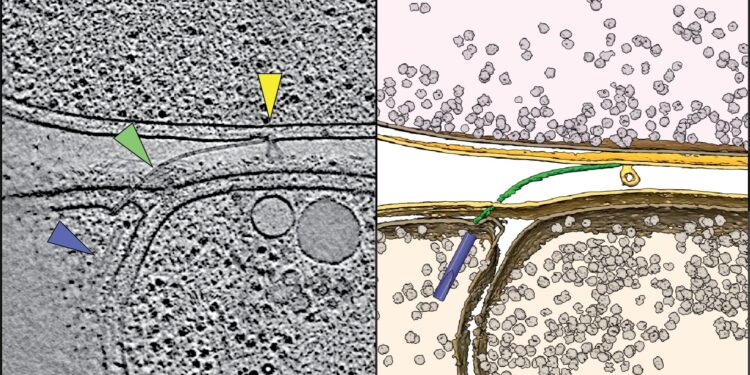Electronic cryo-tomography (left) and 3D model (right) of the on-board gun of the hunting bacteria Aureispira. Credit: Yun-Wei Lien / ETH Zurich
Countless bacteria inhabit the vastness of the oceans, and they all face the same problem: the nutrients they need to grow and multiply are rare and unevenly distributed in the waters around them. In some places they are present in abundance, but in many places they are severely lacking. This led some bacteria to become efficient hunters to exploit new sources of sustenance in the form of other microorganisms.
Although this strategy is very effective, researchers have so far found only a few predatory bacterial species. One is the soil bacteria Myxococcus xanthus; another is Vampirococcus, which sucks its prey like a vampire.
In a new study, ETH Zurich researchers led by Martin Pilhofer, professor at the Department of Biology, together with his colleagues Yun-Wei Lien and Gregor Weiss, presented another of these rare bacterial predators: the filamentous marine bacterium Aureispira . The article is published in the journal Science.
Among the molecular structures that researchers have identified in Aureispira, some resemble grappling hooks and serve a similar purpose. The bacteria also has a type of bolt gun that it uses to kill its prey.
Like a pirate ship searching for a potential victim, Aureispira quickly glides across solid surfaces toward its prey, such as Vibrio bacteria. If the attacker itself floats freely in the water, it waits for its prey to approach. As soon as there is close contact, the grappling hooks become entangled in the victim’s flagella, and the victim can no longer escape.
Within seconds, Aureispira fires its onboard cannons to punch holes in the membrane of the Vibrio bacteria. In collaboration with the laboratory of Professor Roman Stocker at ETH, the researchers were able to show that cellular components that escape from the victim are quickly absorbed by the predator as food. “The whole scene looks like a pirate raid on another ship,” says Pilhofer.
Only when the nutrient concentration in its environment is low does Aureispira become predatory. As long as the nutrient supply is sufficient, the pirate bacteria refrains from catching prey and abandons its arsenal of weapons. However, putting the bacteria on a diet awakens its desire to hunt and causes the cell to rebuild the cannons and grappling hooks. Scientists call this selectively predatory lifestyle ixotrophy.
In collaboration with Martin Polz’s group from the University of Vienna, the researchers were also able to discover that this predatory lifestyle does not only occur in the laboratory but also in marine samples.
New imagery reveals details
The researchers used several imaging techniques, including optical microscopy and cryo-electron microscopy, to understand the function and molecular structure of the grappling hooks and cannons.
This method made it possible to preserve and analyze molecular structures free of artifacts and in their cellular context. With an improved version of the method, it is even possible to determine the molecular structure of the proteins that constitute the bacteria’s weapons.
“All of these imaging techniques are available at the ScopeM competence center at ETH Zurich, which made this study possible,” explains Weiss.
What are the discoveries used for? “This is, above all, fundamental research driven by our curiosity,” explains Pilhofer. He and his colleague Weiss have been working for ten years to elucidate contractile injection systems, the name given to the cannons carried by the pirate bacteria.
In other predatory bacteria, contractile injection systems are often also loaded with toxins to immediately kill the prey. It is conceivable that such bacterial bolt guns could be loaded with active ingredients intended to be injected into individual cells using a molecular machine.
Some predatory bacteria are known to attack cyanobacteria or blue-green algae. This means they could be used to combat algae blooms or to stop the massive spread of Vibrio bacteria. “These bacterial predators are very efficient at what they do,” says Weiss.
More information:
Yun-Wei Lien et al, Mechanism of bacterial predation via ixotrophy, Science (2024). DOI: 10.1126/science.adp0614. www.science.org/doi/10.1126/science.adp0614
Quote: Catching prey with grappling hooks and cannons: the unusual weapon arsenal of a predatory marine bacteria (October 17, 2024) retrieved October 17, 2024 from
This document is subject to copyright. Except for fair use for private study or research purposes, no part may be reproduced without written permission. The content is provided for informational purposes only.



